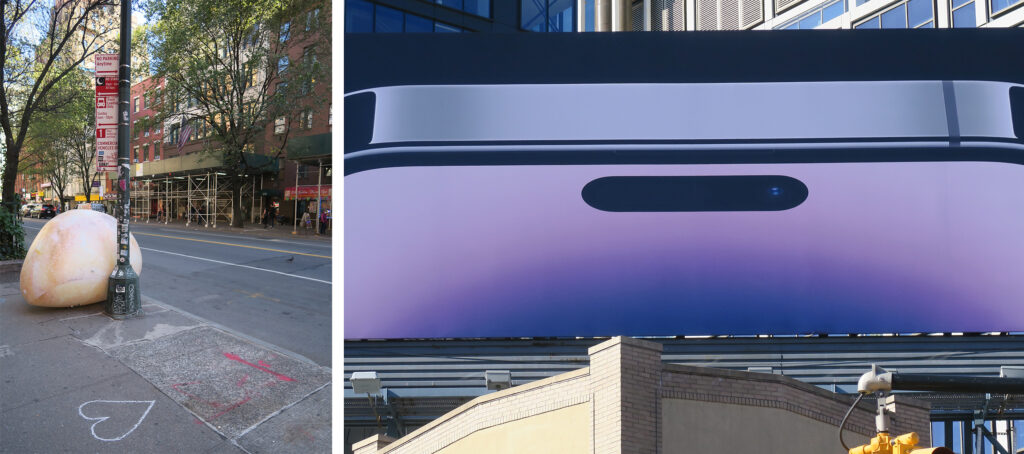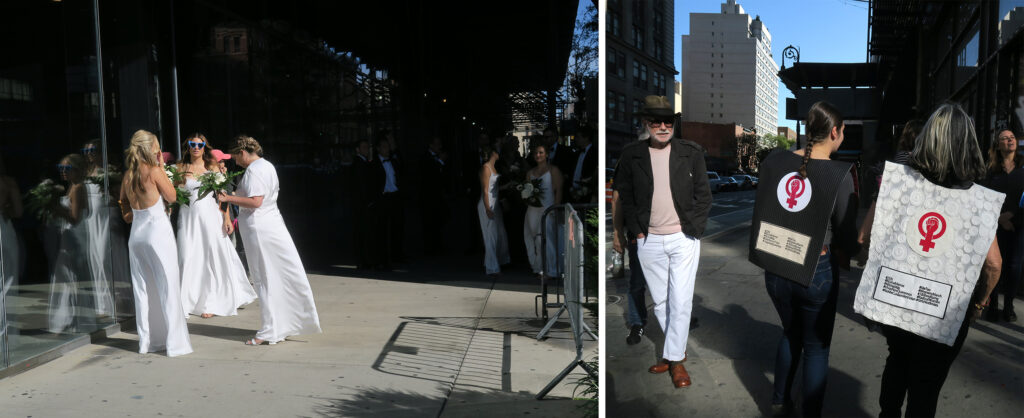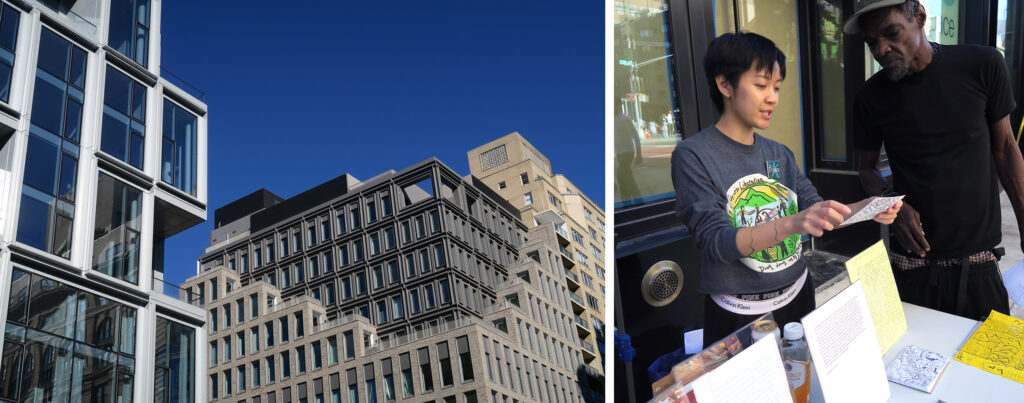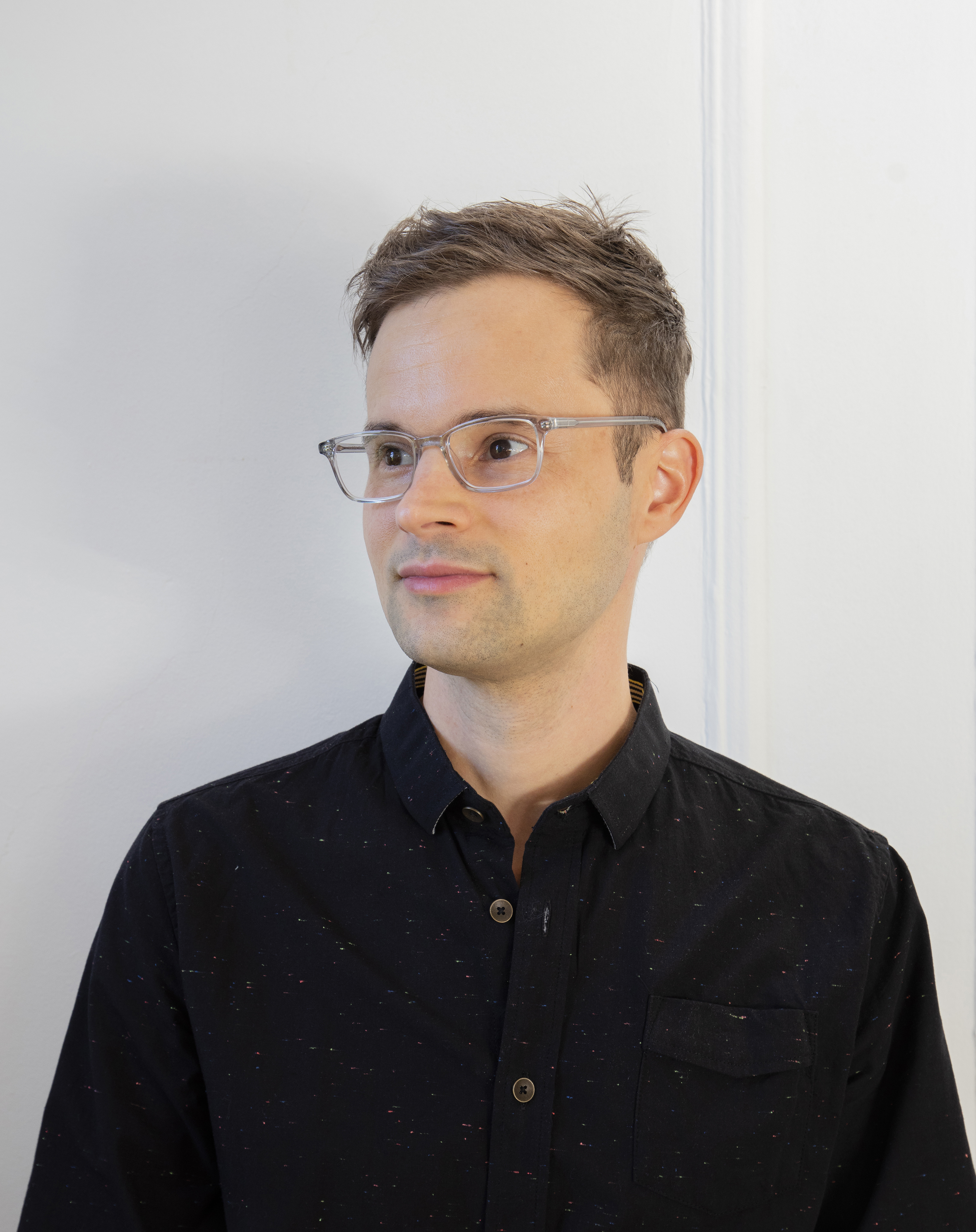On 14th Street, A Weaving of Stories
By Matthew López-Jensen

(Photo pairing by Matthew López-Jensen)
I arrived at the Bureau of General Services Queer Division (BGSQD) bookstore just in time to get one of the last metal folding chairs on the ramp. It was my first time in the physical bookstore after discovering the website a few years ago. I didn’t realize how happy it would make me to step into a queer bookstore. For a flash I was 23 again and at The Oscar Wilde Bookshop in Greenwich Village or The Big Cup coffeehouse in Chelsea. I was reminded how necessary queer spaces are for the community. At BGSQD I was surrounded, quite literally, by stories; arms and faces and fingers of Disney characters melting into one amorphous constellation on fresh pink walls. The artwork of Catalina Schliebener Muñoz had recently been installed and it made the perfect stage for this year’s Art in Odd Places (AiOP) 2022: STORY festival. The mustached men on the spines of Tom of Finland books watched me as I watched a selection of the artists in this year’s festival share their stories.
I was slightly electrified and emotional by the simple act of sitting in a room with people and breathing air and not worrying (too much) about getting Covid. And I wasn’t exactly sure whether we would be experiencing works of performance or listening to stories or a combination of both.
Listening to stories.
Each of the artists who presented would be performing a work along 14th Street. Now we would gain some perspective on the work. And listen to stories.
Nick M. Daniels, founder of the D.A.N.A Movement Ensemble in Pittsburg shared their powerful near-death experience with medicines and also explained how earlier that day they had spent hours tethered to the steel supports of the High Line, trying to pull the entire structure forward, even if only by an unmeasurable amount. They succeeded. The story and the action were unrelated. But not really.
Heather Sincavage, whose work underscores the trauma of intimate partner violence, read us a story, her story. It was moving. The details are best heard in person. But I can say that she can drive a stick shift now. And she will pick you up.
Vivek Sebastian, shared a story, perhaps unintentionally, about a relative in India who found themselves in hot water for developing their own version of a lottery. And he shared that his mother always asks him to buy her scratch-off lottery tickets but he never does. Throughout the festival he would be handing out good luck charms, objects made from the castoff misfortunes of others.
It was hard to understand everything that incarcerated artist Juan Hernandez had to say. His voice, recorded earlier, came from a phone held near the microphone by artist Mai Tran as an extension of the social practice project Art Across Walls. Juan spoke about the struggles of making art and securing materials against so many odds. Along with his story we could hear sounds in the air: slamming of doors, distant voices, and the echoey din of hard spaces. The world around him became part of his story and it was heard by everyone in the bookstore.
Yu-Ching Wang’s performance Breathing in New York involved the artist walking around 14th Street wearing a now outlawed plastic Key Foods bag over her head. Tonight, she was not wearing the bag. Instead, she bravely shared a story about the overlapping circumstances (casual racism, the pandemic, a ban on plastic bags) that converged to inspire this performance.
Jessica Elaine Blinkhorn, curator of this year’s festival, an artist whose work focuses on LGBTQ+, disabled, and aging communities, also shared a story during the Q & A. She didn’t need the microphone because, as she explained, she grew up in a big family in the South. A few years ago she performed a work where she asked strangers passing by on the sidewalk to help her eat. It is a tender and seemingly simple action that most of us take for granted. A man agreed to assist while his girlfriend watched on from a safe distance. Afterwards, however, he wouldn’t shake her hand.
The stories shared were small glimpses into much larger chapters of the lives of the artists who would be performing on 14th Street. I was reminded of how wonderful it is to listen to words coming from the mouths of other people, words that move through physical space, bounce off walls and vibrate against the world, all before entering my ears. What comes out of our computers and headphones is not the human voice, it is something else, close enough for most situations, but not good enough stories.
A few weeks before AiOP 2022: STORY kicked off, I started thinking about the festival’s theme of “STORY” and about 14th Street, where the festival unfolds and has since 2008. How would artists and their stories emerge along this busy corridor? Is 14th Street still an odd place? Should I also share a story? It only seems fair.

(Photo pairing by Matthew López-Jensen)
“They say that I have the best ass below 14th Street. Is it true?”
I was not a musical theater fan, but I signed up (and found the money) to take the five-hour bus ride to New York City to see Rent at the Nederlander Theater. My small circle of misfit friends were beside themselves for the opportunity to see (or see again) the musical that changed everything. The charter bus buzzed with snippets of songs erupting from the riders who had the soundtrack memorized. The vaguely-Catholic university which had sanctioned the trip must not have been aware of the script. But neither was I.
I was going through things that year, specifically that month. It was the late 90s and I was only eighteen and hadn’t learned to see the future. I felt doomed. I was locked into a narrative I had no control over. I sat through the production clenching my teeth, unmoved by the heartache and struggles. Rent was playing out before me like a cautionary tale. I left the theater in a dark place. I pretended to sleep on the ride home. But I was really strategizing how to claw my way deeper into the closet. Avoiding New York City would be a good start.
But five years later I had nowhere else to go. Thankfully the darkness had receded. I was finally out and proud. My job in the Midwest had ended and everything I owned was in the back of my Chevy S-10 pick-up truck. I was on the outskirts of Newark at that point on the highway where Manhattan emerges like a mirage on the horizon. It was the closest thing to a “sign,” so I decided to move to New York from the slow lane of the I-78.
I spent the night in the living room of a high school friend who taught middle school in the suburbs. When I explained that I’d be moving to New York he offered to show me a few neighborhoods he’d visited. I told him, “take me to one of the old parts.” When I explained I had very little money and didn’t know anyone – not a single person – in all of New York City, he told me about a new website called Craigslist.
It was my first time on the subway and we emerged at 14th Street Union Square. Something found me immediately, an impression that fastened that exact moment in my mind; a blast of sunlight, skateboarders clacking down wide stone steps, a public space that seemed wonderfully irreverent. Twenty four years later I still hear Mimi’s voice in my head at least once a week as I arrive for work on 14th Street.

(Photo pairing by Matthew López-Jensen)
As a stage for Art in Odd Places I wonder if 14th Street is still odd enough? There is certainly something odd about so many people excited to go to the Apple Store. And a three-day-old chicken Caesar wrap for sale at a CVS residing in a marble bank building designed like a Roman temple, is certainly odd. Unfathomable sums of money have transformed the western-most blocks. New condominiums creep further east every year, while anxious doormen lurk about plate glass thresholds. Sweeping away artists trying to perform on the sidewalk might certainly be in the job description.
As I walked on the north side of the street, I was excited to spot the occasional artist. During Saturday’s “critical mass” when most of the artists are positioned somewhere it is hard to know where to rest your attention. I listened to a poet with The Armchair Salon timidly read a poem. I listened to a quiet proclamation on the faintest megaphone I’ve ever heard. I saw Jauregui-Ortiz’s three beautiful paintings installed on fencing and Wes Holloway tying ties to the same fence. I saw Christopher Kaczmarek walking with a building on his back and laughed as a team of dusty contractors with neon hard hats lost their minds at the sight of the performance. I lingered, but not long enough, by Nick M. Daniels, while they performed a durational performance, a combination of movement and spoken word. I enjoyed watching the occasional person stop to puzzle, photograph, or talk with an artist. And I wished, in so many situations, that I could stop the traffic, set up some chairs, and invite everyone to learn more about each artist’s story.
Matthew López-Jensen is usually outside. He is a Bronx-based, interdisciplinary environmental artist whose projects combine walking, collecting, gardening, mapping, photography, people, and research. He is a Guggenheim Fellow in photography and has received support from the National Endowment for the Arts for site-specific, landscape projects. His work is in the collections of the Metropolitan Museum of Art, The National Gallery of Art and the Brooklyn Museum, among other institutions. He teaches at Fordham University and Parsons School of Design. He received his MFA from the University of Connecticut and BA from Rice University. www.Jensen-Projects.com @mattlopezjensen


